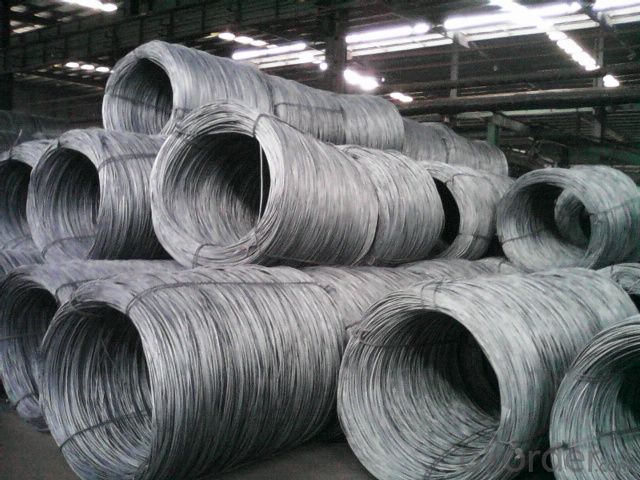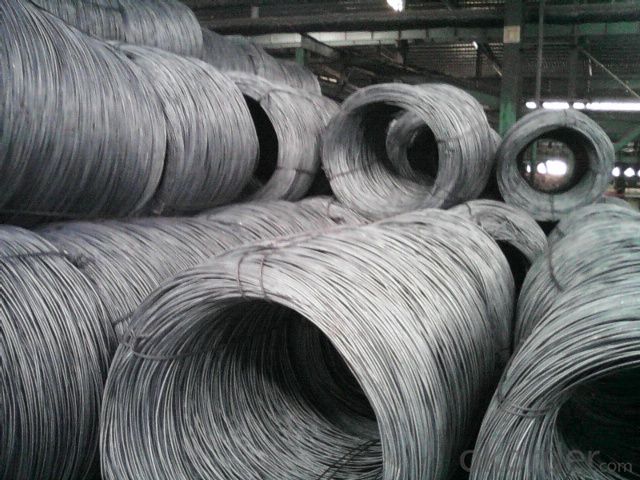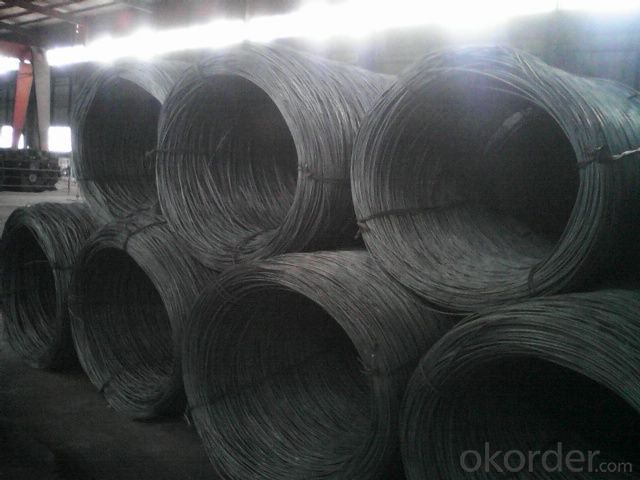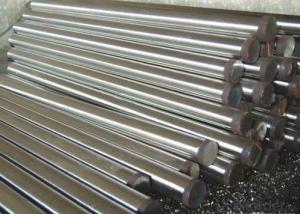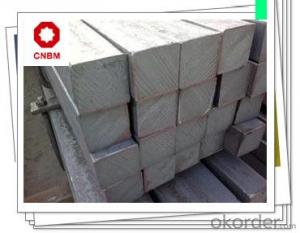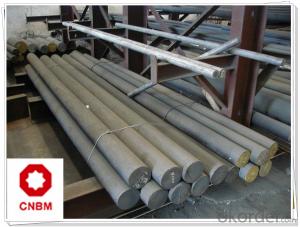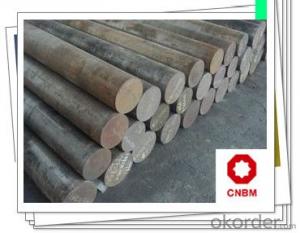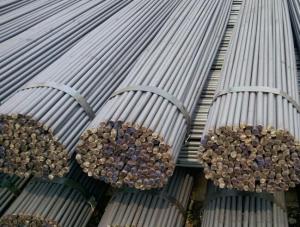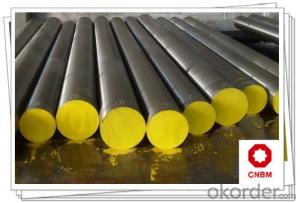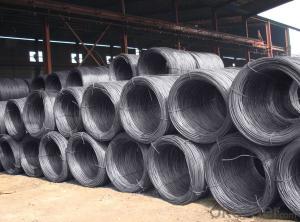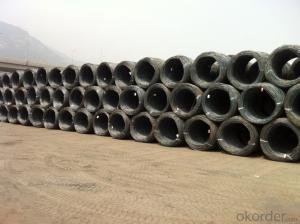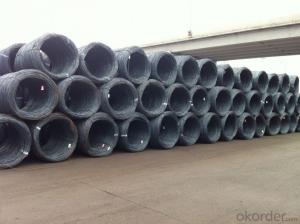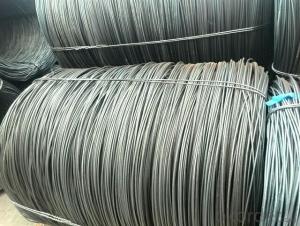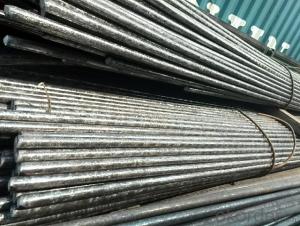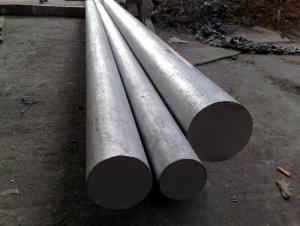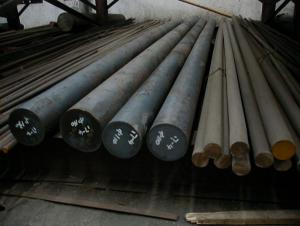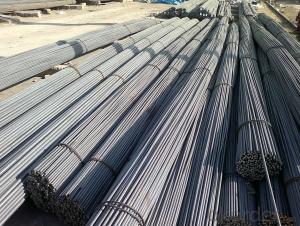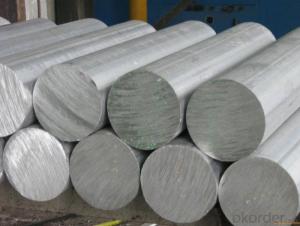High Quality Steel Wire Rod SAE1008, SAE1010
- Loading Port:
- Lianyungang
- Payment Terms:
- TT OR LC
- Min Order Qty:
- 25 m.t.
- Supply Capability:
- 200000 m.t./month
OKorder Service Pledge
OKorder Financial Service
You Might Also Like
Specifications of High Quality Steel Wire Rod SAE1008, SAE1010:
Steel Grade: Q195/235, SAE1006-1018B Standard: ASTM, GB
Diameter: 5.5mm, 6.5mm, 7mm,8mm,9mm,10mm,12mm,14mm
Type: in coil, coil weight around 2MT Alloy or Not: Alloy
Technique: Hot Rolled Place of Origin: China Mainland
Surface: round, no twisted, light and smooth Brand Name: HSKY
Chemical Composition: (Please kindly find our chemistry of our material based on Q195、Q235A and Q235B as below for your information)
| Trademark | Rank | Chemical composition (quality score) % | |||||
| C | Si | Mn | S | P | |||
| ≤ | ≤ | ≤ | |||||
| Q195 | 0.06-0.12 | 0.30 | 0.25 | 0.050 | 0.045 | ||
| Q235 | A | 0.14-0.22 | 0.30 | 0.30-0.65 | 0.050 | 0.045 | |
| Q235 | B | 0.12-0.20 | 0.30 | 0.30-0.70 | 0.045 | 0.045 | |
Usage and Applications of High Quality Steel Wire Rod SAE1008, SAE1010:
After hot-rolled the products shaped into coil and delivery as finished product, including round, square, rectangular, hexagonal and so on. Since most of the products are round, it is generally called wire rod. Carbon steel wire rod is widely used in construction and manufacturing. Carbon steel wire rod is mainly used for reinforcement of reinforced concrete and welded structure or reprocessed (roberts , nail, etc.) materials, especially used to produce wire drawing, welding electrode, nails, spring, electronic, precise machinery parts and so on.
Packaging & Delivery of High Quality Steel Wire Rod SAE1008, SAE1010:
Packaging Detail: products are packed in coil, each coil weight around 2 MT, and then shipped by container or bulk vessel
Delivery Detail: within 45 days after received deposit or LC.
Label: to be specified by customer, generally, each bundle has 1-2 labels
Trade terms: FOB, CFR, CIF
Hot Rolled Wire Rod in Container
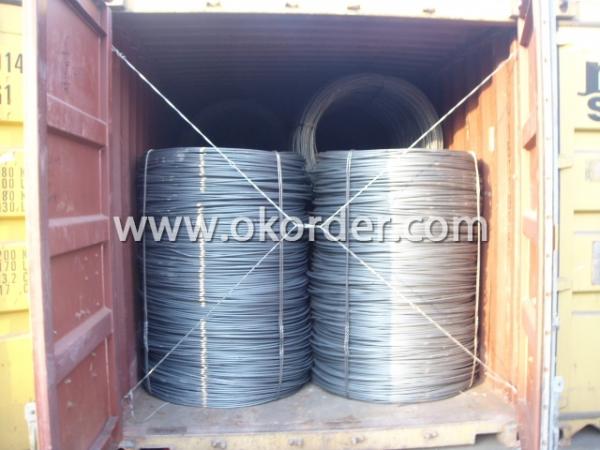
Hot Rolled Wire Rod in Bulk Vessel
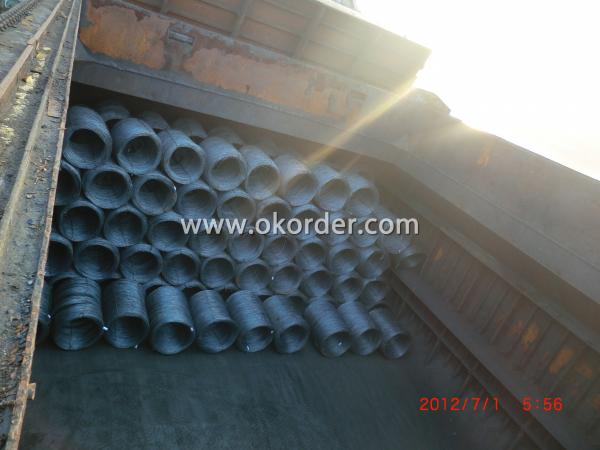
Note:
1. Our products are produced according to national standard (GB), if not, supply according to national standards (GB) or agreement as customer required.
2. Other Grade and Standard carbon steel wire rod we can supply:
Grade: H08A, 30MnSi, 62B-82B
Standard: AISI, BS, JIS, DIN
The Minimum Order Quantity of these products is high, and need to be confirmed.
3. We can not only supply carbon steel wire rod; if you need anything about building materials, please contact us.
4. Please send us your detail specifications when inquire. We will reply to you as soon as possible. We sincerely hope we can establish a long stable business relationship.
- Q: Are steel round bars suitable for the production of axles?
- Yes, steel round bars are suitable for the production of axles. Steel round bars are known for their high strength and durability, making them ideal for the heavy-duty requirements of axles. They can withstand the forces and stresses applied during operation, ensuring the axles can efficiently support and transmit the load. The round shape of the bars also allows for easy machining and forming into axles of various sizes and configurations.
- Q: How do steel round bars perform under cyclic loading?
- Steel round bars typically perform well under cyclic loading due to their high strength and ductility. When subjected to repeated or cyclic loading, these bars can withstand significant stress without experiencing deformation or failure. The fatigue behavior of steel round bars is influenced by various factors, such as the material composition, heat treatment, and surface finish. Steel bars with higher tensile strength and hardness tend to exhibit better resistance to fatigue, as they can withstand higher stress levels before failure occurs. Under cyclic loading, steel round bars undergo stress cycles that cause alternating compression and tension forces. These cycles can lead to the initiation and propagation of cracks, ultimately leading to failure. However, steel's inherent ductility allows it to absorb energy and redistribute stress, which helps to mitigate crack propagation and extend the fatigue life of the bar. The fatigue strength of steel round bars is typically determined through fatigue tests, where the bars are subjected to a specified number of stress cycles until failure occurs. The results of these tests provide valuable information on the endurance limit and fatigue life of the steel bar under different loading conditions. To enhance the fatigue performance of steel round bars, various techniques can be employed, such as shot peening, surface coating, and residual stress induction. These techniques can introduce compressive stress on the bar's surface, which helps to inhibit crack initiation and propagation, thereby improving its fatigue resistance. Overall, steel round bars are reliable and durable under cyclic loading, making them suitable for applications that involve repeated or fluctuating stresses, such as structural components, automotive parts, and machinery components. However, it is essential to consider the specific loading conditions, material properties, and design criteria when selecting steel round bars to ensure optimal performance and longevity.
- Q: Are steel round bars suitable for the production of axles?
- Yes, steel round bars are suitable for the production of axles. Steel round bars are known for their high strength and durability, making them ideal for the heavy-duty requirements of axles. They can withstand the forces and stresses applied during operation, ensuring the axles can efficiently support and transmit the load. The round shape of the bars also allows for easy machining and forming into axles of various sizes and configurations.
- Q: Can steel round bars be used in the manufacturing of kitchenware?
- Yes, steel round bars can be used in the manufacturing of kitchenware. Steel is a durable and versatile material that is commonly used in the production of kitchen utensils and cookware. Steel round bars can be shaped and molded into various kitchenware items such as pots, pans, knives, spoons, and forks. The strength and heat resistance of steel make it suitable for cooking and food preparation purposes. Additionally, steel is easy to clean, hygienic, and resistant to corrosion, making it ideal for use in kitchenware.
- Q: Can steel round bars be used in the production of electrical equipment?
- Yes, steel round bars can be used in the production of electrical equipment. Steel is a highly versatile and durable material that can provide structural support and conductivity in various electrical components. The round shape of the bars allows for easy fabrication and assembly, making them suitable for use in electrical equipment manufacturing.
- Q: Are steel round bars available in different shapes other than round?
- No, steel round bars are specifically designed and manufactured in a cylindrical shape.
- Q: What are the advantages of using boron-alloy steel round bars?
- Using boron-alloy steel round bars in various applications offers several advantages. Firstly, compared to traditional carbon steel, boron-alloy steel has significantly higher strength. This increased strength enables the construction of lightweight and durable structures, reducing material costs and improving overall efficiency. Additionally, boron-alloy steel round bars exhibit excellent hardenability. This means they can be heat-treated to achieve desired properties such as increased hardness and wear resistance. This makes them ideal for demanding applications in industries like automotive and construction, where high strength and durability are necessary. Another advantage of boron-alloy steel round bars is their enhanced weldability. They can be easily welded without sacrificing their mechanical properties, allowing for seamless integration into various fabrication processes. This saves time and effort during assembly and ensures the structural integrity of the final product. Furthermore, boron-alloy steel round bars offer excellent resistance to abrasion and corrosion. This makes them suitable for use in harsh environments or applications where exposure to chemicals or moisture is common. The extended lifespan of the material reduces the need for frequent repairs or replacements, resulting in cost savings and improved productivity. Lastly, boron-alloy steel round bars are readily available and cost-effective compared to other high-strength steel alternatives. Their wide availability makes them a viable option for a range of applications, from manufacturing machinery to constructing infrastructure. In summary, the benefits of using boron-alloy steel round bars include higher strength and durability, improved hardenability, enhanced weldability, resistance to abrasion and corrosion, and cost-effectiveness. These advantages make them an excellent choice for various industries that require lightweight, strong, and long-lasting materials.
- Q: Can steel round bars be used for making interior components?
- Yes, steel round bars can be used for making interior components. They are often used in various applications such as handrails, furniture, fixtures, and decorative elements due to their strength, durability, and versatility.
- Q: What are the advantages of using carbon steel round bars?
- Using carbon steel round bars in various applications offers several advantages. To begin with, carbon steel round bars are renowned for their exceptional strength and durability. They possess a high tensile strength, making them ideal for heavy-duty tasks that involve carrying substantial loads and enduring intense pressures. As a result, carbon steel round bars find extensive use in the construction, manufacturing, and engineering sectors. Another benefit of carbon steel round bars lies in their remarkable machinability. They can be effortlessly cut, drilled, and shaped into diverse forms, rendering them highly versatile for different projects. This flexibility allows for precise and accurate fabrication, ensuring that the desired specifications and dimensions are achieved. Furthermore, carbon steel round bars exhibit excellent weldability, enabling easy joining using various welding techniques. This feature makes them highly preferred for constructing structures and machinery that demand strong and secure connections. Moreover, carbon steel round bars offer a cost-effective solution compared to other materials with similar properties. They strike an optimal balance between performance and affordability, making them a favored choice across many applications. Additionally, their long lifespan and minimal maintenance requirements contribute to cost savings over time. Carbon steel round bars also possess a high resistance to corrosion and wear, thanks to the presence of carbon and other alloying elements. This enhanced resistance shields them from external factors like moisture, chemicals, and abrasion. Consequently, carbon steel round bars can endure harsh environments and prolonged exposure to various elements, making them well-suited for outdoor applications. Lastly, the widespread use and popularity of carbon steel round bars ensure their ready availability in the market. They can be found in various sizes, grades, and specifications, allowing users to select the most suitable option for their specific needs. This availability streamlines the sourcing process and reduces lead times for projects. In conclusion, the utilization of carbon steel round bars provides numerous advantages, including exceptional strength, excellent machinability, good weldability, affordability, corrosion resistance, and availability. These qualities establish carbon steel round bars as a reliable and versatile choice for a wide range of applications across different industries.
- Q: Can steel round bars be used in the production of flanges?
- Flanges in the production process can utilize steel round bars. Steel round bars, commonly used as raw materials, can be machined, forged, or rolled into the desired flange shape. The production of flanges benefits from steel round bars due to their high strength, durability, and resistance to corrosion. Additionally, they can be easily fabricated and machined to meet specific size and dimensional needs. Various industries, including oil and gas, petrochemical, power generation, and construction, widely employ steel round bars for the production of flanges. These flanges are essential in connecting pipes or equipment within piping systems.
Send your message to us
High Quality Steel Wire Rod SAE1008, SAE1010
- Loading Port:
- Lianyungang
- Payment Terms:
- TT OR LC
- Min Order Qty:
- 25 m.t.
- Supply Capability:
- 200000 m.t./month
OKorder Service Pledge
OKorder Financial Service
Similar products
Hot products
Hot Searches
Related keywords



